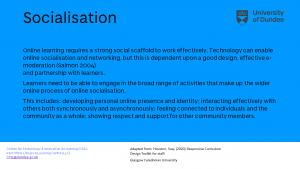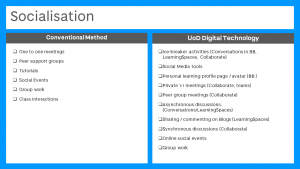Introduction
Next up is the topic Socialisation.
You’ll find the Socialisation example on slides 15 and 16 in the full slide deck


Moving online
Social presence is one of the most significant factors in improving instructional effectiveness and building a sense of community. (Steven R. Aragon 2003). As we increasingly rely on using virtual spaces and other online collaboration tools to communicate with our learners, it is crucial in your role and presence as an online tutor and e-moderator, to understand how the activities you develop may impact on your student’s social learning experience. Socialisation with your students should begin at the start of all modules to set the scene and rhythm of your programme and not be viewed as something that only happens when doing induction with first year students.
The rapid increase in digital technologies (Moodle, Blackboard, Collaborate, Twitter …) has and continues to change and shape the way you can deliver your teaching. Kop, Fournier, and Mak (2011) contend that “the structure of the learning environment, the place and presence of learners and educators within the institutional boundaries, and the nature of knowing and learning are all challenged by the fast pace of technological change” (p. 74).
We have all experienced situations in the physical space where we have had to socialise and interact with others, for example on the first day at university, starting a new job or attending a conference event. In the physical space, we have developed and adopted over time approaches in observing social cues to deal with this form of social interaction (wait and observe, look for people who you think are similar to yourself, seek out people you might know etc). When engaged in online interactions, these cues can be more ambiguous, thus requiring a different approach when moving to the online space. Tu & McIsaac (2002) and Aragon (2003) ‘place high importance in using engagement tactics, in online classrooms, geared towards increasing social presence and reducing distance’.
Transitioning to a more online blended learning format, requires your course to be an online ‘Place’ for learning and not just a ‘Space’ for learning. Some tips on how to prepare for a more connected community of inquiry with your students are:
- Communicate regularly: routinely maintain a consistent online presence by timetabling dedicated slots for discussion both formal and informal with students and other tutors. Use the MyDundee discussion forum to foster discussion and engagement. In episode 2 of this series: The Bigger Picture Emma discussed Universal Design for Learning. You may find some of the tips there helpful when preparing your students for studying on your programme at a distance.
- Personalised sessions: nothing beats the opportunity to have an open 1-on-1 (or small group) session with your tutor. Timetable these into your teaching schedule – it fosters that sense of belonging and community – have 1-on-1 sessions via Blackboard Collaborate.
- Create an environment of trust, humanity and warmth: Introduce and speak about yourself and likewise ask your students to introduce themselves. Use the MyDundee forum to start this and then perhaps move towards a more virtual face-2-face discussion using Blackboard Collaborate when your students feel more relaxed.
- Establish ground rules: Do not assume your students know the rules of engagement when interacting online with you and your programme, clear guidance at the outset about how they behave when in a virtual place will help to set expectations about appropriate behaviours – this has been covered in more detail in the Digital Wellbeing and Safety episode last week.
- Motivate your students: Think of ways to motivate your students. If you run online discussion forums, students can be assessed on their level of contribution and engagement. Think about your activities and how you can add-in ‘fun’ quizzes to supplement these activities.
- Seek Feedback: Feedback provides a constructive way that can help you develop your teaching practice and move your students learning forward. Ask for feedback on how the teaching is going – this will help you to review and make changes in the early stages of your teaching.
Over to you
I hope you have enjoyed this discussion topic. Below are some questions to think about and discuss/share with your colleagues in relation to ‘Socialisation’ in learning and teaching (use the comments option box below 😉 ).
- Have you taken any online courses or attended online workshops yourself? What were the most engaging and enjoyable features and how might you employ those in your own practice?
- What ice-breakers do you typically use with your students in the classroom and how might those translate into online activities?
- What’s your favourite online communication tool and why?
- What approaches might you consider when you design your online activities, to ensure students have an equal opportunity to contribute?
Other Dundee Resources
If you want to get your students to engage with you and each other online, why not post a weekly topic for discussion on your MyDundee module forum and gamify it by giving points for contribution and engagement. A colleague from the Medical School introduced this to year the 4 General Surgery block (whilst on secondment in New Zealand!) and it has proved to be very successful.
There has been many other useful information and resources posted during this Blend Your Module series by other CTIL colleagues which you can dip in and out of any time – and comment on.
References/Further Reading
- Cultivating Social Presence in the Online Learning Classroom – Brandi Scollins-Mantha
- Social Presence, Identity and Online Learning: Research Development and Needs – Patrick R. Lowenthal & Vanessa P. Dennen
- How to Make Online Courses a ‘Place’ for Learning – Debbie Morrison (Online Learning Insights)
- Community of Inquiry Framework: A Retrospective – D. Randy Garrison, Terry Anderson, Walter Archer


For my first online teaching experience a few years ago, I was teaching on a programme with a very internationally disparate cohort of students. I didn’t give the icebreaker too much thought – I asked them, in the chat box, to tell everyone (1) where they were joining from, (2) their favourite non-fiction book, and (3) their favourite fiction book. It worked really well and the chat went on for some time and people were enthusiastically chatting to one another about their favourite books. The only thing was the chat box couldn’t keep up and people were scrolling up and down as they chatted to one another. But overall, it was really effective as a starting point. More luck than design on my part though!